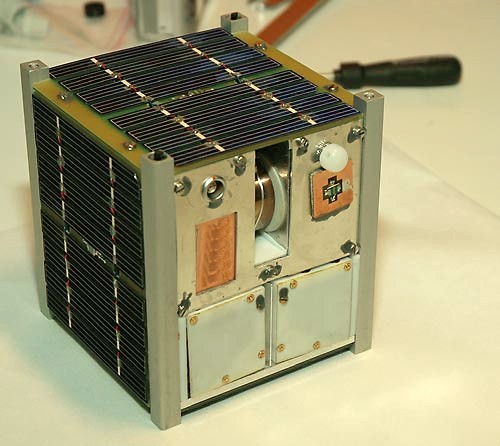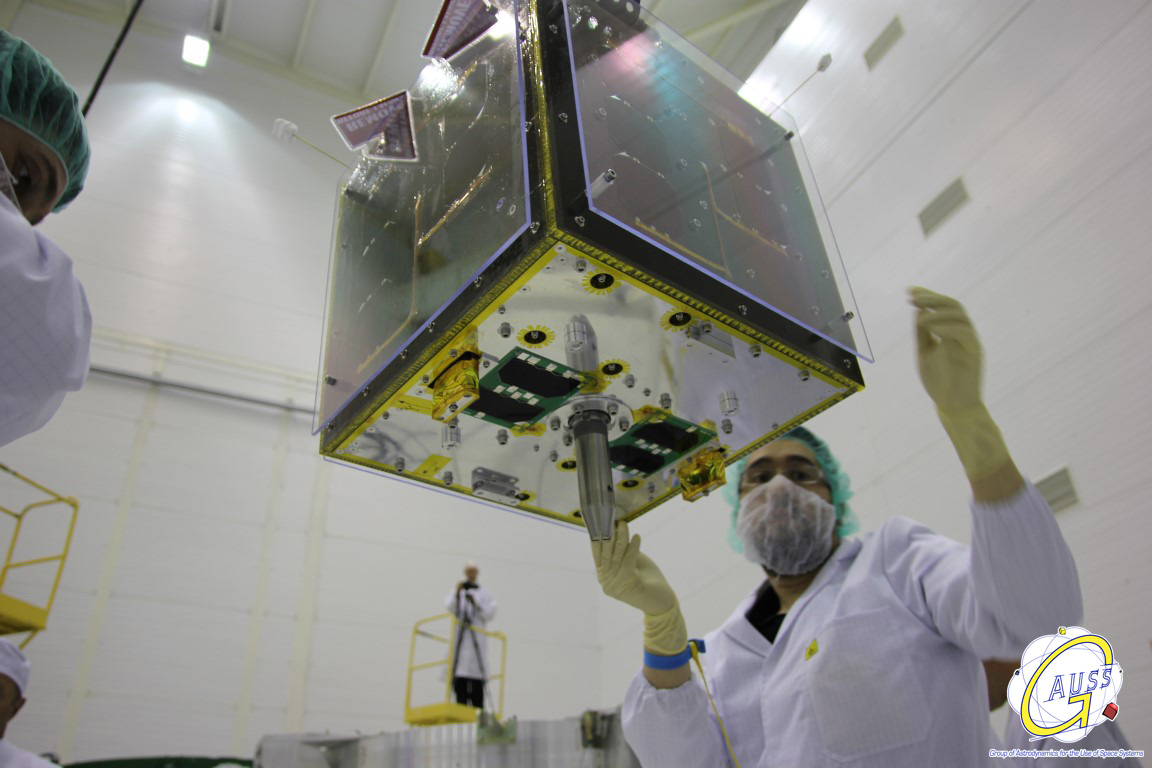|
NEE-02 Krysaor
NEE-02 ''Krysaor'' is an Ecuadorian technology demonstration satellite, and Ecuador's second satellite launched to space. Built by the Ecuadorian Civilian Space Agency (EXA), it is a single-unit CubeSat nanosatellite. ''Krysaor'' is a Pegasus-class spacecraft, a "twin" of Ecuador's first satellite, NEE-01 ''Pegaso''. Like ''Pegaso'', this spacecraft's instruments include a dual visible and infrared camera which allows the spacecraft to take pictures and transmit live video from space. See also *List of CubeSats The following is a list of CubeSats, nanosatellites used primarily by universities for research missions, typically in low Earth orbits. Some CubeSats became their country's first national satellite. The extensivNanosatellite and CubeSat Databas ... References External links ''Krysaor'' official website CubeSats Science and technology in Ecuador Spacecraft launched in 2013 2013 in Ecuador Spacecraft launched by Dnepr rockets {{spacecraft-st ... [...More Info...] [...Related Items...] OR: [Wikipedia] [Google] [Baidu] |
Ecuadorian Civilian Space Agency
The Ecuadorian Civilian Space Agency (EXA; es, Agencia Espacial Civil Ecuatoriana) is a private Ecuadorian organization founded in 2007 that conducts research on space and planetary sciences. It is a non-profit non-governmental organization with civilian oversight. EXA had tested microgravity via Weightlessness#Reduced weight in aircraft, parabolic flight with the Ecuadorian Air Force. EXA launched Ecuador's first satellite, the CubeSat NEE-01 Pegaso, NEE-01 ''Pegaso'', in April 2013 aboard a Chinese Long March 2D. Its second satellite, the follow-on CubeSat NEE-02 Krysaor, NEE-02 ''Krysaor'', was launched from Russia aboard a Dnepr (rocket), Dnepr rocket in November 2013. Notes References External links * (in English) {{authority control Non-profit organisations based in Ecuador Research institutes in Ecuador Space organizations ... [...More Info...] [...Related Items...] OR: [Wikipedia] [Google] [Baidu] |
CubeSat
A CubeSat is a class of miniaturized satellite based around a form factor consisting of cubes. CubeSats have a mass of no more than per unit, and often use commercial off-the-shelf (COTS) components for their electronics and structure. CubeSats are put into orbit by deployers on the International Space Station, or launched as secondary payloads on a launch vehicle. , more than 1,600 CubeSats have been launched. In 1999, California Polytechnic State University (Cal Poly) professor Jordi Puig-Suari and Bob Twiggs, a professor at Stanford University Space Systems Development Laboratory, developed the CubeSat specifications to promote and develop the skills necessary for the design, manufacture, and testing of small satellites intended for low Earth orbit (LEO) that perform a number of scientific research functions and explore new space technologies. Academia accounted for the majority of CubeSat launches until 2013, when more than half of launches were for non-academic purposes, ... [...More Info...] [...Related Items...] OR: [Wikipedia] [Google] [Baidu] |
Dnepr (rocket)
The Dnepr rocket (russian: Днепр, translit=Dnepr; uk, Дніпро, translit=Dnipró) was a space launch vehicle named after the Dnieper River. It was a converted ICBM used for launching artificial satellites into orbit, operated by launch service provider ISC Kosmotras. The first launch, on April 21, 1999, successfully placed UoSAT-12, a 350 kg demonstration mini-satellite, into a 650 km circular Low Earth orbit. History The Dnepr was based on the R-36 (missile), R-36MUTTH Intercontinental ballistic missile (ICBM)called the ''SS-18 Satan'' by NATOdesigned in the 1970s by the Yuzhnoe Design Bureau in Dnepropetrovsk, Ukrainian SSR. The Dnepr control system was developed and produced by the Khartron, JSC "Khartron", Kharkiv. The Dnepr was a multistage rocket, three-stage rocket using storable hypergolic liquid propellants. The launch vehicles used for satellite launches have been withdrawn from ballistic missile service with the Russian Strategic Rocket Forces a ... [...More Info...] [...Related Items...] OR: [Wikipedia] [Google] [Baidu] |
Dombarovsky (air Base)
Dombarovsky (also given as Dombarovskiy and Tagilom) is a military airbase northwest of the village of Dombarovsky, near Yasny in Russia's Orenburg Oblast. Operated by the Soviet Air Forces and later by the Russian Air Force, it hosted fighter interceptor squadrons and hosts an ICBM base (which has been adapted for commercial satellite launches) with a supporting helicopter base. The site is divided into three sites: * The former main runway and dispersals: * The current ICBM base: * The current ICBM support helicopter base: home to the 84th Independent Helicopter Squadron of the 13th Red Banner Rocket Division Interceptor base The facility featured three revetment compounds. The 412th Fighter Aviation Regiment (412 IAP) flew from the base with Sukhoi Su-9 (Fishpot) aircraft in the early 1970s. The regiment replaced it in 1978 with the Mikoyan-Gurevich MiG-23M (Flogger-B). [...More Info...] [...Related Items...] OR: [Wikipedia] [Google] [Baidu] |
Dombarovsky Site 370 of Orenburg Oblast, Russia
{{Disambiguation, geo ...
Dombarovsky (masculine), Dombarovskaya (feminine), or Dombarovskoye (neuter) may refer to: *Dombarovsky District, a district of Orenburg Oblast, Russia *Dombarovsky (air base), an interceptor aircraft base in Orenburg Oblast, Russia *Dombarovsky (rural locality), a rural locality (a settlement) in Dombarovsky District Dombarovsky District (russian: Домбаровский райо́н; kk, Дамбар ауданы, ) is an administrativeLaw #1370/276-IV-OZ and municipalLaw #2367/495-IV-OZ district (raion), one of the administrative divisions of Orenburg Oblas ... [...More Info...] [...Related Items...] OR: [Wikipedia] [Google] [Baidu] |
Geocentric Orbit
A geocentric orbit or Earth orbit involves any object orbiting Earth, such as the Moon or artificial satellites. In 1997, NASA estimated there were approximately 2,465 artificial satellite payloads orbiting Earth and 6,216 pieces of space debris as tracked by the Goddard Space Flight Center. More than 16,291 objects previously launched have undergone orbital decay and entered Earth's atmosphere. A spacecraft enters orbit when its centripetal acceleration due to gravity is less than or equal to the centrifugal acceleration due to the horizontal component of its velocity. For a low Earth orbit, this velocity is about ; by contrast, the fastest crewed airplane speed ever achieved (excluding speeds achieved by deorbiting spacecraft) was in 1967 by the North American X-15. The energy required to reach Earth orbital velocity at an altitude of is about 36 MJ/kg, which is six times the energy needed merely to climb to the corresponding altitude. Spacecraft with a perigee belo ... [...More Info...] [...Related Items...] OR: [Wikipedia] [Google] [Baidu] |
Sun-synchronous Orbit
A Sun-synchronous orbit (SSO), also called a heliosynchronous orbit, is a nearly polar orbit around a planet, in which the satellite passes over any given point of the planet's surface at the same local mean solar time. More technically, it is an orbit arranged so that it precesses through one complete revolution each year, so it always maintains the same relationship with the Sun. Applications A Sun-synchronous orbit is useful for imaging, reconnaissance, and weather satellites, because every time that the satellite is overhead, the surface illumination angle on the planet underneath it is nearly the same. This consistent lighting is a useful characteristic for satellites that image the Earth's surface in visible or infrared wavelengths, such as weather and spy satellites, and for other remote-sensing satellites, such as those carrying ocean and atmospheric remote-sensing instruments that require sunlight. For example, a satellite in Sun-synchronous orbit might ascend acros ... [...More Info...] [...Related Items...] OR: [Wikipedia] [Google] [Baidu] |
Nanosatellite
A small satellite, miniaturized satellite, or smallsat is a satellite of low mass and size, usually under . While all such satellites can be referred to as "small", different classifications are used to categorize them based on mass. Satellites can be built small to reduce the large economic cost of launch vehicles and the costs associated with construction. Miniature satellites, especially in large numbers, may be more useful than fewer, larger ones for some purposes – for example, gathering of scientific data and radio relay. Technical challenges in the construction of small satellites may include the lack of sufficient power storage or of room for a propulsion system. Rationales One rationale for miniaturizing satellites is to reduce the cost; heavier satellites require larger rockets with greater thrust that also have greater cost to finance. In contrast, smaller and lighter satellites require smaller and cheaper launch vehicles and can sometimes be launched in multipl ... [...More Info...] [...Related Items...] OR: [Wikipedia] [Google] [Baidu] |
NEE-01 Pegaso
NEE-01 ''Pegaso'' (, " Pegasus") is an Ecuadorian technology demonstration satellite, and Ecuador's first satellite launched to space. Built by the Ecuadorian Civilian Space Agency (EXA), it is a nanosatellite of the single-unit CubeSat class. The spacecraft's instruments include a dual visible and infrared camera which allows the spacecraft to take pictures and transmit live video from space. Construction and launch After the completion of its HERMES-A ground station in April 2010, EXA authorised the construction of Ecuador's first satellite. A number of restrictions and demands were imposed on the project: EXA was solely responsible for the spacecraft design and technology research, all construction had to take place within Ecuador, the project must be "future-enabling" and result in a technological breakthrough, and its mission must be educational in nature. The completed ''Pegaso'' was presented to the public on 4 April 2011. All research and construction of the satellite ... [...More Info...] [...Related Items...] OR: [Wikipedia] [Google] [Baidu] |
List Of CubeSats
The following is a list of CubeSats, nanosatellites used primarily by universities for research missions, typically in low Earth orbits. Some CubeSats became their country's first national satellite. The extensivNanosatellite and CubeSat Databaselists nearly 4,000 CubeSats and NanoSats have been launched since 1998. The organization forecasts that 2080 nanosats will launch within the next 6 years. Research and development * SBUDNIC was launched to test Arduino Nano and other commercial off-the-shelf technology in space, using a simple, open-source design. * An ambitious project is the QB50, an international network of 50 CubeSats for multi-point by different universities and other teams, ''in-situ'' measurements in the lower thermosphere (90–350 km) and re-entry research. QB50 is an initiative of the von Karman Institute and is funded by the European Union. Double-unit ("2-U") CubeSats (10x10x20 cm) are foreseen, with one unit (the 'functional' unit) providing the usual sat ... [...More Info...] [...Related Items...] OR: [Wikipedia] [Google] [Baidu] |
CubeSats
A CubeSat is a class of miniaturized satellite based around a form factor consisting of cubes. CubeSats have a mass of no more than per unit, and often use commercial off-the-shelf (COTS) components for their electronics and structure. CubeSats are put into orbit by deployers on the International Space Station, or launched as secondary payloads on a launch vehicle. , more than 1,600 CubeSats have been launched. In 1999, California Polytechnic State University (Cal Poly) professor Jordi Puig-Suari and Bob Twiggs, a professor at Stanford University Space Systems Development Laboratory, developed the CubeSat specifications to promote and develop the skills necessary for the design, manufacture, and testing of small satellites intended for low Earth orbit (LEO) that perform a number of scientific research functions and explore new space technologies. Academia accounted for the majority of CubeSat launches until 2013, when more than half of launches were for non-academic purposes, and ... [...More Info...] [...Related Items...] OR: [Wikipedia] [Google] [Baidu] |
Science And Technology In Ecuador
Science is a systematic endeavor that builds and organizes knowledge in the form of testable explanations and predictions about the universe. Science may be as old as the human species, and some of the earliest archeological evidence for scientific reasoning is tens of thousands of years old. The earliest written records in the history of science come from Ancient Egypt and Mesopotamia in around 3000 to 1200 BCE. Their contributions to mathematics, astronomy, and medicine entered and shaped Greek natural philosophy of classical antiquity, whereby formal attempts were made to provide explanations of events in the physical world based on natural causes. After the fall of the Western Roman Empire, knowledge of Greek conceptions of the world deteriorated in Western Europe during the early centuries (400 to 1000 CE) of the Middle Ages, but was preserved in the Muslim world during the Islamic Golden Age and later by the efforts of Byzantine Greek scholars who brought Greek ... [...More Info...] [...Related Items...] OR: [Wikipedia] [Google] [Baidu] |



.jpg)

